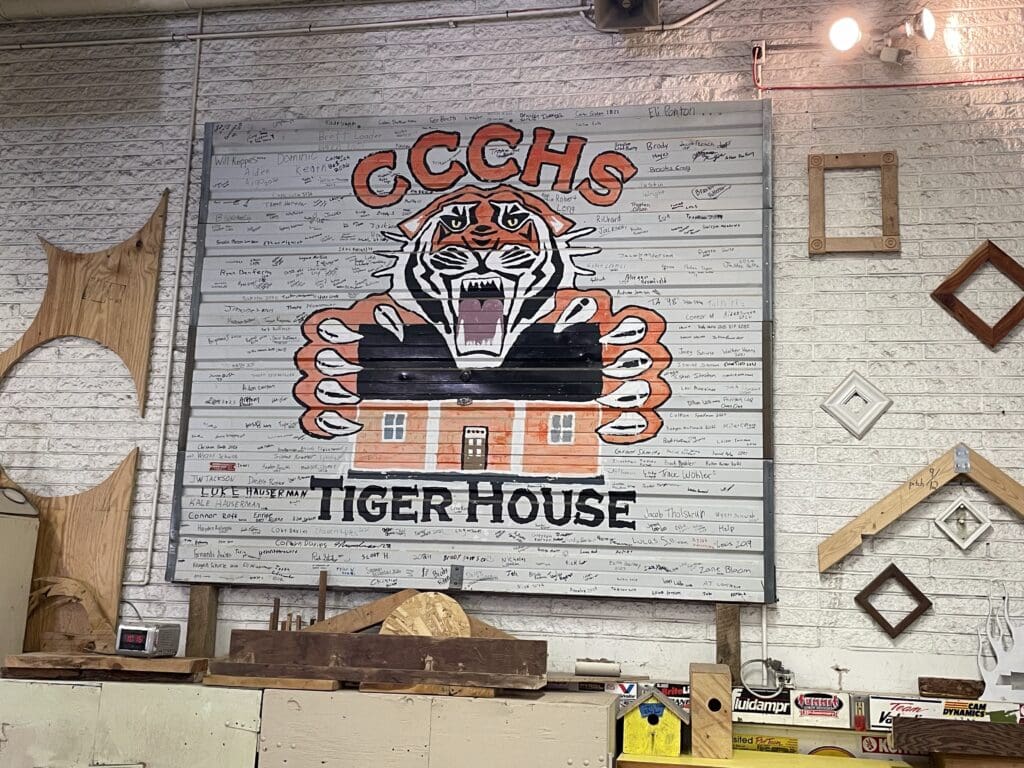CCCHS construction students have built houses for the community since 1970. Five were built on-site throughout the town. More than 30 were built on a foundation north of the school and were then moved to their own foundations. Part 1 of this story was published last week and can be found at KCLYradio.com
On the business side of the Tiger House, USD 379 Business Manager, Andrea Gibson, runs the project as if any construction company would. It’s part of her job to track all construction expenses. At the end of the school year, all expenses are itemized and shared with the buyer, she said.
Because the school purchases items without sales tax, that also has to be added in and charged to the buyer.
Prior to 2014, the completed homes were auctioned and sold to the highest bidder. From 2014 until 2022, the homes were sold as a contract build. The final price of these homes included all incurred hard costs plus a bid amount. The Board of Education determined a minimum bid amount they would accept and received individual sealed bids. The bid amount above hard costs was used to help with utility costs and builders’ risk insurance. That method of sale allowed for buyers to ask for custom finishes or changes to the spec plan. For instance, custom cabinetry vs. basic store-bought versions, certain countertops, and more. Ultimately, it depended on the budget and the personality of the buyer, she said.
“The level of finish was up to the buyer,” she said.
A two-year hiatus was taken to work on the Mark A. Chapman Activities Complex concession stand.
The current school year saw the Tiger House program re-up with a spec-made house, sans finishes. Essentially, the house it completed through Sheetrock, and the buyer will choose trim, cabinetry, and more after the spec house is sold to the buyer. The decision to build a spec house was made by the administration and allows for more student instruction time.
If a buyer does sign on early enough in the project, they can have a say on the floor plan, which is drafted by another CCCHS class.
“People can come in and look through the library of prior plans that fit on the foundation,” she said. “There’s a pretty popular one; it’s kind of just been the tried and true one that everybody wants.”

Today the class is taught by Brandon Pfizenmaier, who became construction design teacher six years ago. He worked under Steve Deutscher, who taught construction at CCCHS for 30 years. While in high school, Pfizenmaier took Deutscher’s class for three years before graduating in 1998. In his senior year, he worked on the house two hours a day; he still remembers that particular house, which is still located south of town.
He said it was that experience that decided his future.
“I really got into it, I loved the teacher,” he said. “That’s what kind of made me figure out what I wanted to do after college.” He attended college for construction management in Kearney, Nebraska, where he wrestled in the NCAA Division II. After placing at state all four years in high school, winning sophomore through senior years, and going 129-6, Pfizenmaier landed several college titles. That included KWCA College Senior Wrestler of the Year, two regional titles, and placing in the nation’s top five for three years.
All of those stats and more can be found in the record books; his matches are even on YouTube. But he doesn’t consider them glory days, nor did he mention them when interviewed. He’s at the school to teach construction and spend time with the kids.
Pfizenmaier worked in construction after graduating from Kearney. He built houses for 15 years, then got a call about teaching construction at his alma mater and took the gig.
“I decided it was more consistent having a job every day,” he said. “Plus, having help on building the house. I’m getting to the age where it’s handy to have 60 kids who are all able to lift things.”
In addition, with four kids of his own, he said it was nice to work in the school system with them and their friends. His second child is currently enrolled in Construction Technology 2, along with 15 others, while his oldest graduated a year before.
“The first year we hit the ground running and built a house,” he said.
Each home is 1,400 square feet, sitting at 52-by-28 feet, with a range of about four floor plans students can choose from.
Since coming back to CCCHS, Pfizenmaier said the 2024-2025 house is his fourth. Another is planned for next year, the 2025-2026 year.
Each school year starts with about three weeks of safety training before they move outside and start working with tools.
“It’s a classroom setting, going over safety. It’s a lot, tools, materials, the jobsite,” he said. “Even I get tired of it after a while, but it’s the most important part of the class. All the kids have to pass safety checks.”
Students also check out tools, a tool bag, and safety glasses at the beginning of the year; it’s their job to keep track of them throughout the year.
Next, Pfizenmaier said they start using elevations, lasers, and more to check the heights of the foundation, square it up, and start adding floor joists.
A lot of the learning is hands-on, while he said they average about one day a week in the books, known as “bookwork days,” to cover a new skill that will be used on the house.
Days are structured with older students in the morning, some who work on building for two consecutive hours – he said this is when the majority of the work is done. Then, younger kids come in, which often consists of larger class sizes.
“Those kids are still learning what they want to do so classes are big,” he said. Adding that these students spend more time in the shop building items like bird or dog houses, deer blinds, or shelves, especially as Christmas presents for their parents.
In his final hour of the day, eighth-grade students walk over and get their own taste of what a high school construction class will be. He added that winter is another time when students of all ages are building in the shop, as housework slows with the weather.
“It’s kind of like being a boss, you teach them as you go, they’re learning as we go,” he said. “It’s hard to teach building looking at a screen, you have to get in there and use your hands and feet.”
Like his predecessor, Pfizenmaier also compared building to coaching – he’s coached both wrestling and baseball. Though working with teenagers can be challenging, his first goal is to get them to work together.”
“Once you get through the teamwork it goes better,” he said. “It’s fun, I enjoy it and I like working with kids.”













